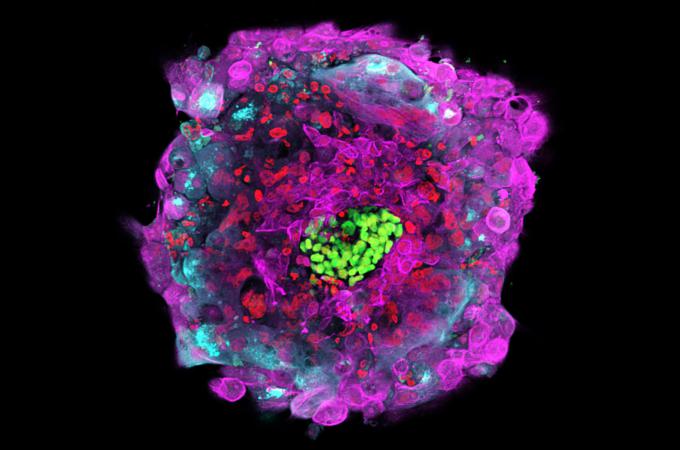Embryos and the '14-Day Rule'
Arguments in favor of research on human embryos typically play off our unfamiliarity with the way that we ourselves once appeared and existed as embryos. Humans in their tiniest stages are indeed unfamiliar to us, and they hardly look anything like "one of us." Yet the undeniable conclusion, that every one of us was once an embryo, remains an indisputable scientific dogma, causing a "fingernails on the chalkboard" phenomenon for researchers every time they choose to experiment on embryos or destroy them for research.
To enable scientists to get beyond the knowledge that they're experimenting on or destroying fellow humans, clever strategems and justifications have had to be devised. Among the more successful of these approaches has been the well-known "14-day rule." This rule, as noted in a recent article in the journal Nature, represents "a legal and regulatory line in the sand that has for decades limited in vitro human-embryo research to the period before the 'primitive streak' appears. This is a faint band of cells marking the beginning of an embryo's head-to-tail axis... The formation of the primitive streak is significant because it represents the earliest point at which an embryo's biological individuation is assured. Before this point, embryos can split in two or fuse together. So some people reason that at this stage a morally significant individual comes into being."
Most people have an instinctive moral awareness when they reflect on the reality that adults come from embryos. A particular conclusion organically follows, namely, that any decision to interrupt an embryo's growth and development involves a willingness to destroy a prospective infant, child, teenager, and adult. Even the natural potential for the splitting and fusing of embryos does not substantively alter the fact that adults arise from embryonic origins when traced back far enough along their particular developmental trajectories. If anything, the possibility that an early embryo might divide and make twins means that a decision to destroy such an embryo might involve "double" the evil, since two future adults are being exploited and exterminated rather than just one.
It is also worth emphasizing that the 14-day rule, despite protestations to the contrary, has not actually restricted real-world human embryo research to any appreciable degree, because scientists have lacked the ability, until quite recently, to culture human embryos in the lab for any length of time beyond about a week. In fact, it was only in 2016 that several new studies figured out how to grow human embryos beyond what the 14-day rule might forbid. The rule, thus, was an agreed-upon convention of no practical significance for any researchers who may have been carrying out experiments on embryonic humans in recent decades. Considering the fact that the rule may now actually begin to hamper what some of them are interested in doing, they are pushing, unsurprisingly, to "revisit" and "recalibrate" the rule.
Historically speaking, the 14-day rule arose largely as a mechanism for justifying what had previously been considered immoral, even unthinkable, research. The rule enabled serious human rights violations to proceed apace under the pretext of providing restrictions and regulatory limitations. By feigning that the 14 day-rule was somehow an ethical tenet grounded in biological facts, promoters of the rule devised a clever way of offering lip service to the moral status of the human embryo. They implied that one could show respect for the human embryo through the establishment of such a rule, even though the rule objectively demonstrated no more respect for vulnerable humanity than German researchers during the war would have, had they declared a "14-year rule," namely, that only concentration camp inmates below the age of fourteen would be experimented upon. Whether 14-days or 14-years, such rules at root constitute mere contrivances to justify unethical science. As bioethicist Daniel Callahan observed back in 1995: "I have always felt a nagging uneasiness at trying to rationalize the killing of something for which I claim to have a 'profound respect.' What in the world can that kind of respect mean? An odd form of esteem -- at once high-minded and altogether lethal."
Hence, the broader strategic goal of conventions like the 14 day-rule has been not to identify or set in place any objective moral lines, nor to acknowledge authentic moral concerns, but to circumnavigate those very concerns by means of the convention, and achieve particular pragmatic outcomes, most notably: the continued expansion of the research, the minimization of "public outcry and backlash," the continued availability of research funding, and the avoidance of legally restrictive embryo-protective measures that might be debated by justly-concerned legislatures. The ultimate goal of a convention like the 14-day rule has been to establish the idea, erroneous at its core, that prior to a certain arbitrarily-determined time point, developing human beings can be deemed sufficiently different from us that an "us and them" chasm can be used to justify their violent exploitation.
- Father Tadeusz Pacholczyk, Ph.D. earned his doctorate in neuroscience from Yale and did post-doctoral work at Harvard. He is a priest of the diocese of Fall River and serves as the Director of Education at The National Catholic Bioethics Center in Philadelphia,



















